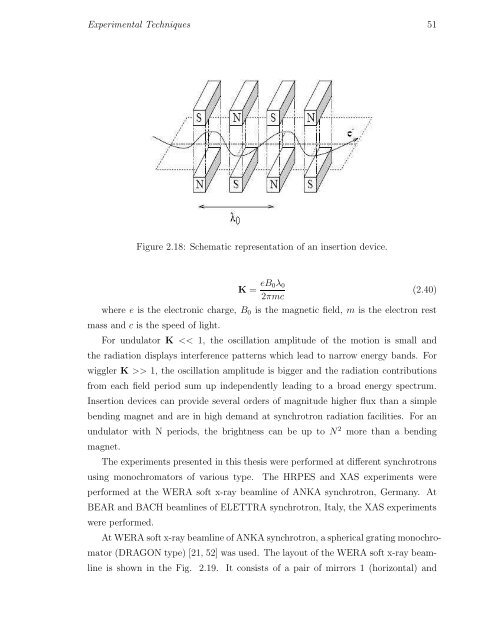PHYS07200604007 Manas Kumar Dala - Homi Bhabha National ...
PHYS07200604007 Manas Kumar Dala - Homi Bhabha National ...
PHYS07200604007 Manas Kumar Dala - Homi Bhabha National ...
You also want an ePaper? Increase the reach of your titles
YUMPU automatically turns print PDFs into web optimized ePapers that Google loves.
Experimental Techniques 51<br />
Figure 2.18: Schematic representation of an insertion device.<br />
K = eB 0λ 0<br />
(2.40)<br />
2πmc<br />
where e is the electronic charge, B 0 is the magnetic field, m is the electron rest<br />
mass and c is the speed of light.<br />
For undulator K > 1, the oscillation amplitude is bigger and the radiation contributions<br />
from each field period sum up independently leading to a broad energy spectrum.<br />
Insertion devices can provide several orders of magnitude higher flux than a simple<br />
bending magnet and are in high demand at synchrotron radiation facilities. For an<br />
undulator with N periods, the brightness can be up to N 2 more than a bending<br />
magnet.<br />
The experiments presented in this thesis were performed at different synchrotrons<br />
using monochromators of various type. The HRPES and XAS experiments were<br />
performed at the WERA soft x-ray beamline of ANKA synchrotron, Germany. At<br />
BEAR and BACH beamlines of ELETTRA synchrotron, Italy, the XAS experiments<br />
were performed.<br />
At WERA soft x-ray beamline of ANKA synchrotron, a spherical grating monochromator<br />
(DRAGON type) [21, 52] was used. The layout of the WERA soft x-ray beamline<br />
is shown in the Fig. 2.19. It consists of a pair of mirrors 1 (horizontal) and
















